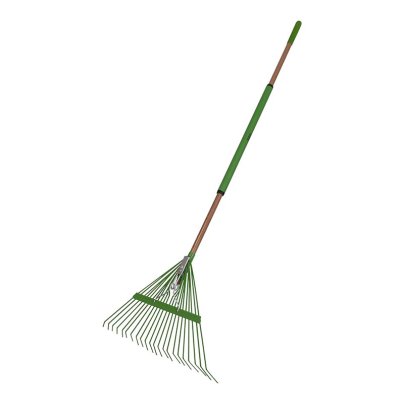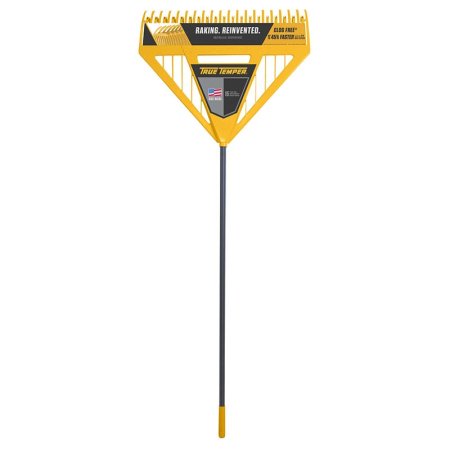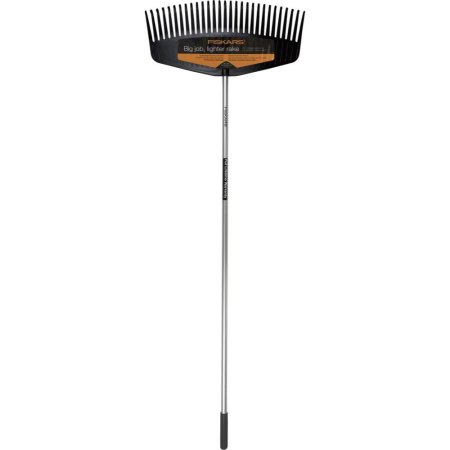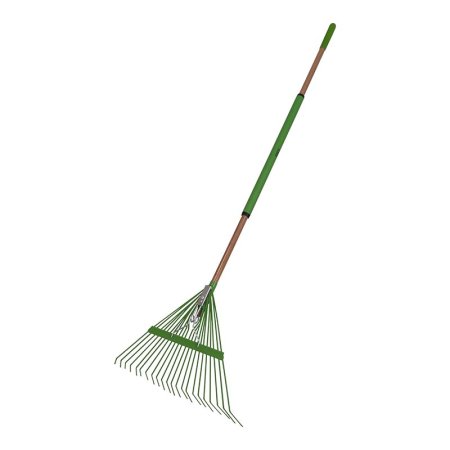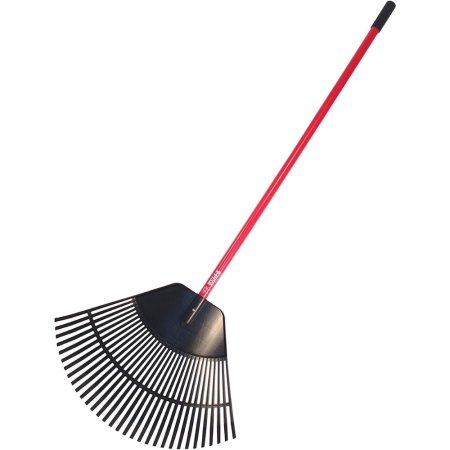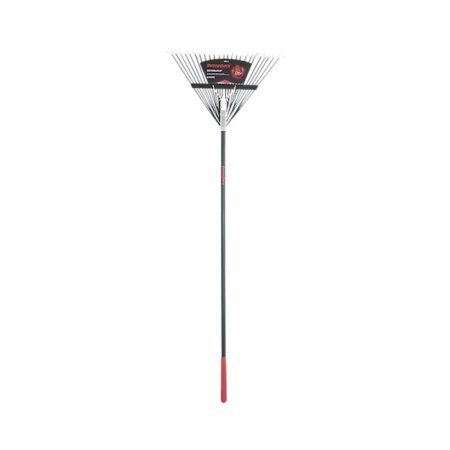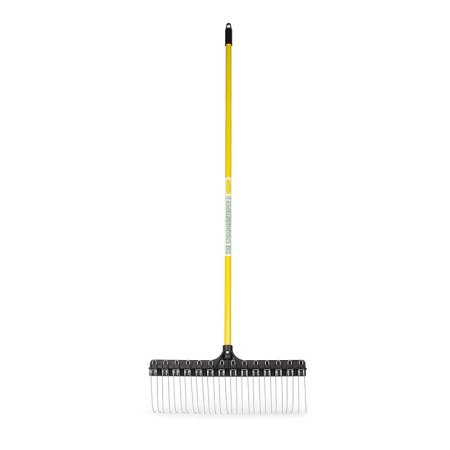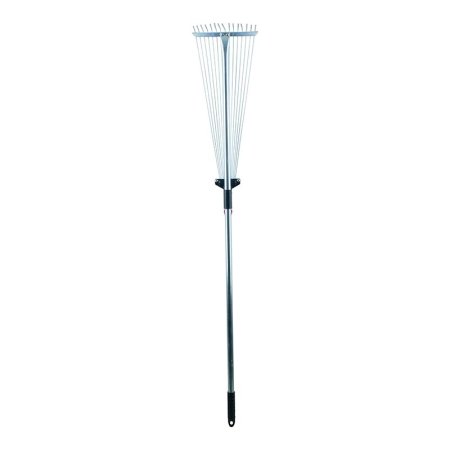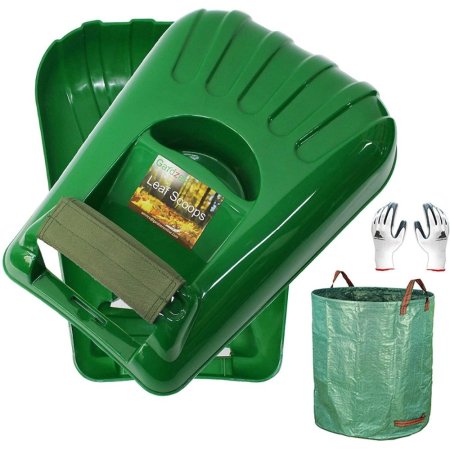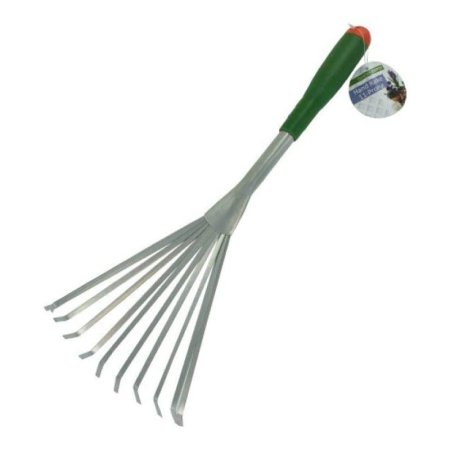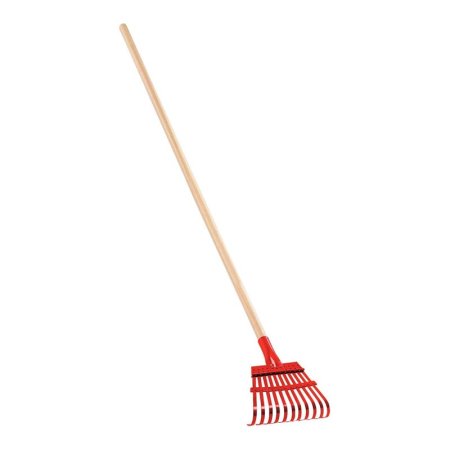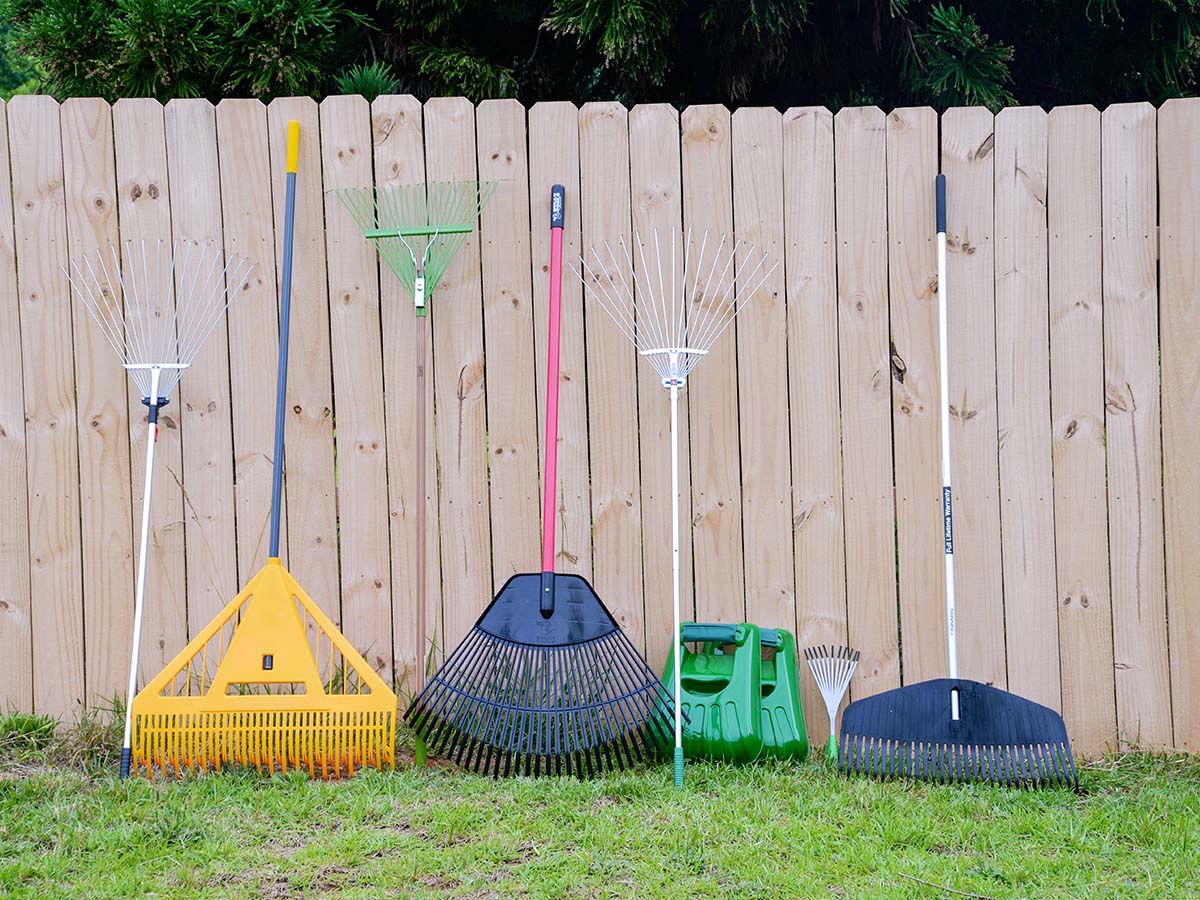
We may earn revenue from the products available on this page and participate in affiliate programs. Learn More ›
We’ve researched more than 30 leaf rakes to compile the following group for testing. As opposed to “hard” rakes used to spread soil and gravel, a typical yard rake is a more flexible tool with a long handle and a triangular fan-shaped head split into multiple tines. Yard and leaf rakes are designed to gather leaves and other detritus on the lawn, around trees and shrubs, and in flower beds.
We tested leaf rakes after narrowing down our initial research and exploring the differences to help you find a quality model to fit your needs. We liked the True Temper 26-Inch Dual-Tine Poly Leaf Rake for its ergonomic design and resistance to leaf-clogging. out the detailed reviews of these models to find the best leaf rake for your needs.
- BEST OVERALL: True Temper 26-Inch Dual-Tine Poly Leaf Rake
↓ Jump to Review - BEST BANG FOR THE BUCK: Fiskars Leaf Rake
↓ Jump to Review - BEST METAL: Ames 22-Tine Steel Leaf Rake
↓ Jump to Review - BEST PLASTIC: Bully Tools Lawn/Leaf Rake With Fiberglass Handle
↓ Jump to Review - BEST HEAVY-DUTY: Razor-Back 51-Inch 24-Tine Steel Rake
↓ Jump to Review - BEST LIGHTWEIGHT: The Groundskeeper II Professional Landscape Rake
↓ Jump to Review - BEST ADJUSTABLE: Bond 2060 Adjustable Steel Rake
↓ Jump to Review - BEST LEAF SCOOP: Gardzen Large Leaf Scoop Hand Rakes
↓ Jump to Review - BEST HAND RAKE: Garden Depot Gardening Hand Rake
↓ Jump to Review - BEST SHRUB RAKE: Corona 8-Inch Fixed-Tine Shrub Rake
↓ Jump to Review
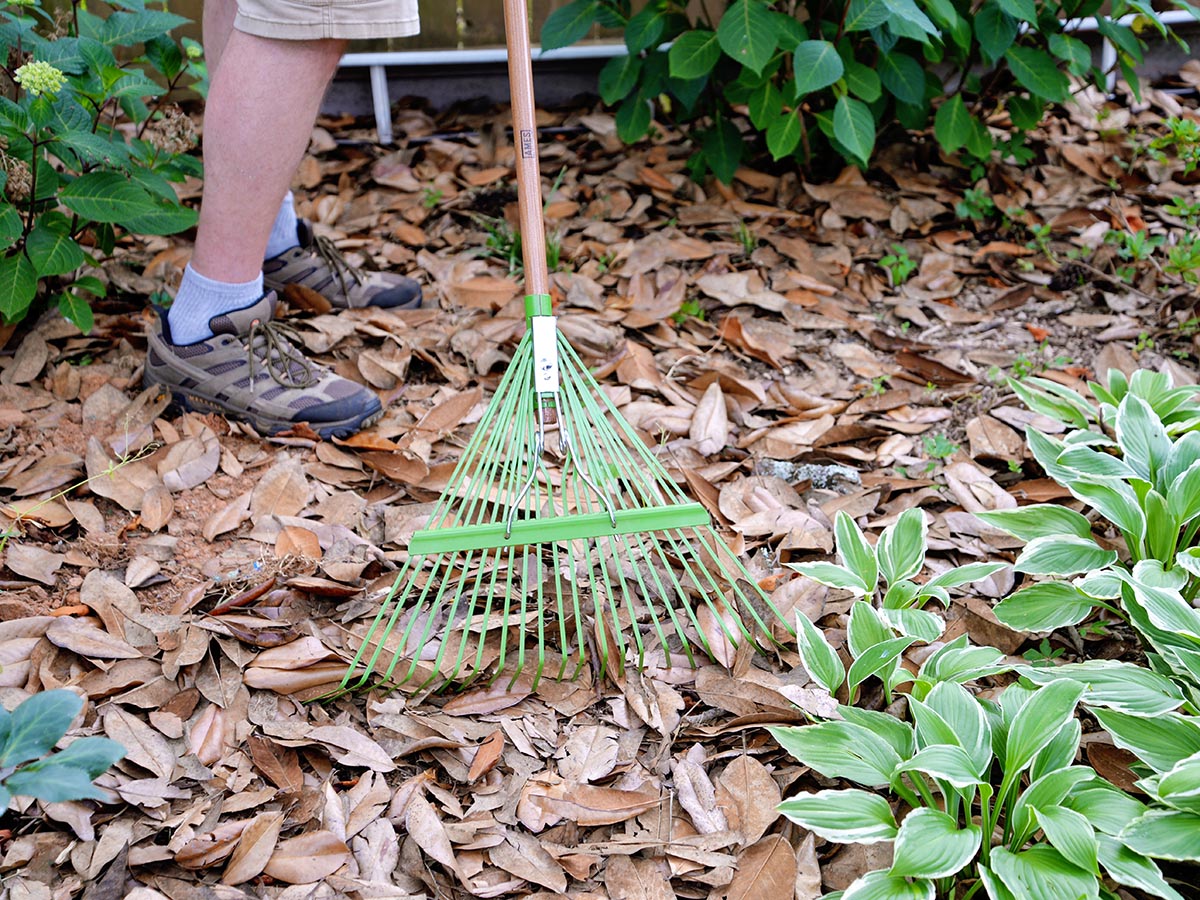
| Testing Stats | |
| Products tested | 10 |
| Time spent testing | 2 days |
| Tests performed | 4 |
| Price range | $9 to $45 |
Our Top Picks
Some find the outdoor task of raking leaves calming, while others would rather do almost anything else. No matter what your attitude is, read on to find out how each of these tested rakes performed in our backyard trials and why we consider them some of the best in their categories.
BEST OVERALL
True Temper 26-Inch Dual-Tine Poly Leaf Rake
Product Specs
- Type: Standard
- Materials: Polyresin head, rubber-coated steel handle
- Tine count: 39
This Bob Vila Approved product carries our brand’s highest level of recommendation.

Bob Vila Approved recognizes the household and DIY products that impressed us most in our real-world testing and that exemplify core values of the Bob Vila brand, including craftsmanship, innovation, and value for the dollar. Winners of this designation come recommended by our professional review team and are personally approved by Bob Vila.
Our Ratings: Ergonomics 4/5; Durability 4/5; Effectiveness 4.4/5; Value 4.3/5
What We Like
- Dual-tine design resists clogging with leaves
- Wide head covers a large area
- Lightweight, durable materials
- Comfortable design; less hand and shoulder strain
What We Don’t Like
- Plastic tines are less flexible and springy than steel tines
- May require assembly
Two of the worst aspects of leaf cleanup season are the time commitment and physical exertion that raking requires. This dual-tine poly leaf rake by True Temper helps get the job done quickly and easily thanks to its lightweight, efficient design. The rake measures 27 inches wide and 71 inches from the tip of the tines to the top of the handle, and it weighs a modest 2.75 pounds. It features an efficient dual-tine design with alternating straight and curved tines, which aggressively collects leaves and debris while resisting clogging.
We awarded the True Temper dual-tine poly leaf rake “Best Overall” because it works as advertised. In our tests, the dual tines really did collect more debris faster, including hard-to-reach pine needles, acorns, and grass thatch, eliminating the need to double rake. We liked that the working edge where the tines meet the ground is relatively flat because it allows the rake to pick up more new material on each stroke regardless of the user’s height. However, the tines are quite stiff, which makes them less suitable for applications where “digging in” is less desirable.
Get the True Temper leaf rake at Tractor Supply Co., Ace Hardware, or Amazon.
BEST BANG FOR THE BUCK
Fiskars Leaf Rake
Product Specs
- Type: Standard
- Materials: Polyresin head, aluminum handle
- Tine count: 29
Our Ratings: Ergonomics 5/5; Durability 4/5; Effectiveness 3.8/5; Value 4.7/5
What We Like
- Lightweight aluminum and polyresin
- Oval profile covers more ground with reduced range of motion
- Broad head quickly clears areas with low to moderate leaf cover
- Flexible curved tines resist clogging with twigs and pine cones
- Budget-friendly price for a good-quality rake
What We Don’t Like
- Extra-wide plastic head is not well reinforced
- Thin aluminum handle can bend with excessive downward pressure
This leaf rake by Fiskars maintains the company’s brand reputation for comfortable, quality performance at a budget-friendly price. It offers durable, lightweight construction designed for comfort without sacrificing performance. This Fiskars rake measures 24 inches wide and 67 inches from tine tip to handle top, and it weighs just 1.5 pounds.
We liked the Fiskars leaf rake’s oval-profile handle. In addition to giving the tubular aluminum shaft a bit more resistance to bending, the shape fit in our hands comfortably. The rake’s pliable polyresin tines feature a strong downward curve and somewhat flat working edge that reached among the grass blades to pull out settled debris without tearing up the grass. The soft tine material limits this rake to lightweight leaf cleaning, but it excels in that role. This rake is a good choice for small to medium yards but might not hold up to especially sizable acreage.
Get the Fiskars leaf rake at Menards.
BEST METAL
Ames 22-Tine Steel Leaf Rake
Product Specs
- Type: Standard
- Materials: Steel head, hardwood handle
- Tine count: 22
Our Ratings: Ergonomics 4/5; Durability 5/5; Effectiveness 4.4/5; Value 4.7/5
What We Like
- Steel spring-tine head with wood handle
- Durable materials
- Well adapted to raking leaves on grass, gravel, or soil
- Steel-tine head is more versatile than polyresin
What We Don’t Like
- Steel tines are susceptible to bending
- Head is smaller than many polyresin leaf rakes; covers less area
For its versatility, this old-fashioned spring-tine rake has an enduring place in the yard. Ames’ version of this classic tool is not only a great leaf rake, but it also works really well to pick up small branches, spread gravel and mulch, and prepare bare soil for planting as a small garden rake. The rake measures 21.75 inches wide and 64.5 inches from the tip of the tines to the top of the handle, and it weighs 2 pounds. The flat working edge makes it a great choice for all types of yard cleanup projects.
If we had to choose only one yard cleanup tool, this rake would be it. It moves fall leaves at a comparatively slower pace than some of the other rakes we tested, but its compact build and durable materials make it the better tool for year-round tasks like cleaning up after pruning or preparing a new garden bed. However, the Ames 22-tine steel leaf rake has a smallish head, and its 21.75-inch width isn’t the most efficient for moving bulky dry leaves. Yet its relatively light weight somewhat offsets the compact size and makes the work less physically demanding. Users of smaller stature may find the rake’s size to their advantage. This Ames leaf rake could be an excellent primary rake for small to midsize yards or one used in combination with a leaf blower/vacuum and lawn mower.
Get the Ames leaf rake at Amazon, Tractor Supply Co., or The Home Depot.
BEST PLASTIC
Bully Tools Lawn/Leaf Rake With Fiberglass Handle
Product Specs
- Type: Standard
- Materials: Polyresin head, fiberglass handle
- Tine count: 32
Our Ratings: Ergonomics 4/5; Durability 5/5; Effectiveness 4.2/5; Value 4.3/5
What We Like
- Thick-walled fiberglass handle and heavy-duty polyresin head
- Broad head moves lots of leaves quickly
- Thick handle allows for an easier grip and reduced hand and wrist fatigue
What We Don’t Like
- Nearly twice the weight of other standard leaf rakes
- Excessive curve in the working edge where the tines meet the ground
Heavy or wet leaves and large yards call for a heavy-duty leaf rake. The Bully Tools lawn and leaf rake not only has a rugged fiberglass handle that resists bending, cracking, or breaking, but its smooth surface is easy on users’ hands. The rake measures 30 inches wide and 68 inches from the tips of the tines to the top of the handle, plus it weighs a stout 3.25 pounds. The rake comes disassembled but is easy to put together: Simply insert the handle into the head and secure it with a screw.
Our tests revealed several interesting points about the Bully Tools leaf rake. With its thick, strong handle and massive curved head, it can pull large, heavy loads of leaves. The tines feature curved tips that can even pull up saturated, matted debris. The deeply concave head and strongly curved working edge make this rake most practical when heavy-duty efforts are necessary. However, in those conditions, some users may prefer a slightly smaller-headed rake. In average or lightweight conditions, the tool is unnecessarily heavy. This rake could make an ideal secondary rake for those times or locations when the conditions are truly difficult.
Get the Bully Tools leaf rake at Amazon or Bully Tools.
BEST HEAVY-DUTY
Razor-Back 51-Inch 24-Tine Steel Rake
Product Specs
- Type: Standard
- Materials: Fiberglass handle, steel tines
- Tine count: 24
Our Ratings: Ergonomics 5/5; Durability 5/5; Effectiveness 4/5; Value 4.5/5
What We Like
- Heavy-duty construction; 24 steel tines and a fiberglass handle
- Just 2.52 pounds; compatible with long workdays
- Multitasking design works well for leaves, gravel, and garden soil
What We Don’t Like
- Smaller rake head is not as fast at leaf cleanup as larger plastic rakes
For all-day comfort and reliability year after year, choose a heavy-duty professional-quality tool like the Razor-Back steel tine rake. It features a replaceable one-piece head with 24 steel tines that resist bending, separation, and clogging. The steel rake head and flexible coil spring give this leaf rake better durability and smoother raking action than plastic rakes for yards. The 51-inch fiberglass cushioned-grip handle reduces weight while enhancing durability.
We preferred the Razor-Back leaf rake over all others as an all-purpose landscaping rake because of its rugged (but not too heavy) construction. Weighing just over 2.5 pounds, it was light enough to rake leaves for hours at a time, but we also used it to rake gravel and garden soil with excellent results. The steel tines had the perfect balance of rigidity and springiness to clean up the lawn without damaging the grass. It was not as fast at leaf cleanup compared to some of the broad-headed plastic models, but it might be the preferred choice for those who value multitask tools.
Get the Razor-Back leaf rake at Tractor Supply Co., The Home Depot, or A.M. Leonard.
BEST LIGHTWEIGHT
The Groundskeeper II Professional Landscape Rake
Product Specs
- Type: Standard
- Materials: Copolymer head and steel head, fiberglass handle
- Tine count: 28
Our Ratings: Ergonomics 3.5/5; Durability 5/5; Effectiveness 3.5/5; Value 4.5/5
What We Like
- Lightweight at under 2 pounds
- Durable; works hard with minimal user fatigue
- Multiuse rake for leaves; dethatching; and leveling soil, mulch, or gravel
- Independently spring-loaded tines resist clogging with leaves and debris
What We Don’t Like
- Digs into the soil more aggressively than other rakes
- Tines are attached at a different angle than other rakes; may feel awkward
- Curved tines easily snag on horizontal grass and weed stems
A rake does not have to be heavy to work hard: The Groundskeeper II is a professional-grade landscaping rake built to take on the rigors of leaf removal, dethatching, leveling soil, spreading mulch, and more. The 21-inch-wide copolymer head features 28 steel tines, each equipped with its own built-in torsion spring. Equipped with a lightweight fiberglass handle, the rake weighs just 1.8 pounds.
Unlike the flat tines on other steel leaf rakes, those on the Groundskeeper II have round profiles that allow them to dig in without down pressure. They are angled so the user stands upright while raking, which eliminates the back pressure common to raking. In addition to raking leaves, our tests indicated that this rake could be a good option for general-purpose lawn and garden maintenance.
The Groundskeeper II felt entirely different from the other standard rakes for gardening in our test due to its downward-curved tines. It was so lightweight that its aggressiveness was sort of a surprise. The tines poked right through the grass to the soil surface. For longer leaf raking strokes, we had to use a very light touch. But for dethatching, just a little downward pressure was all it took. Dense turf-type grasses like Bermuda and spreading weeds like crabgrass made the going tougher because the tines gripped the ground-hugging horizontal stems.
Get the Groundskeeper II leaf rake at Amazon, The Home Depot, or A.M. Leonard.
BEST ADJUSTABLE
Bond 2060 Adjustable Steel Rake
Product Specs
- Type: Adjustable
- Materials: Steel head and handle
- Tine count: 15
Our Ratings: Ergonomics 4/5; Durability 4/5; Effectiveness 3.6/5; Value 4/5
What We Like
- Easily adjusts width from 7 to 22 inches for different tasks
- Rigid round tines work more aggressively than flat spring tines
- Sturdy steel body and adjustment lever
- Lightweight space-saving design
What We Don’t Like
- Tines were more likely to spear leaves and become clogged
- Narrow tubular steel handle is less comfortable than others
This adjustable and collapsible leaf rake from Bond fills the roles of two tools: a conventional leaf rake and a shrub rake. It’s 22 inches wide when fully opened, has a 48-inch handle, and weighs 1.69 pounds. At just 7 inches wide when collapsed, it’s one of the easiest rakes to store.
This was the first time we had used a collapsible rake, and it was a revelation. The tine spread was easy to adjust, and the rake was easy to store. Overall, the Bond 2060 adjustable steel rake was surprisingly effective at taking on many of the same tasks that a spring-tine rake is used for. However, the widely spaced tines sometimes speared the leaves and became clogged, and the round steel handle was too thin for comfortable extended use. For most users, this would not be a great pick for regular year-round yard work. But for those with small yards and only a few seasonal leaves to pick up, it does the job well and stays conveniently out of the way when not in use.
Get the Bond leaf rake at Amazon or Greenhouse Megastore.
BEST LEAF SCOOP
Gardzen Large Leaf Scoop Hand Rakes
Product Specs
- Type: Scoop
- Materials: Polyresin
- Tine count:
Our Ratings: Ergonomics 4/5; Durability 5/5; Effectiveness 5/5; Value 4/5
What We Like
- Scoops quickly; securely collect a large amount of leaves and debris
- No awkwardly protruding rake in the way; convenient to handle
- Easy on/off design comfortably fits all hand sizes
- Protects hands from thorny, prickly yard debris; no need for gloves
What We Don’t Like
- Specialized tool for a single job
- No convenient, compact way to store them
- Does not reduce bending and stooping
When the leaves are all piled up, they still must be loaded for disposal. Using the Gardzen leaf scoop hand rakes, you can grab more leaves than ever and make quick work of loading them into bags or bins. Each leaf scoop measures 17 inches long by 13 inches wide, and the pair weighs 2.42 pounds. The scoops are made from molded polyresin in an ergonomic shape that’s just right for picking up oodles of dry leaves. In addition to the leaf scoops with removable wrist pads, the kit includes a pair of work gloves, protective hand padding, and a 72-gallon reusable leaf bag.
We tested the Gardzen leaf scoop hand rakes on magnolia leaves thoroughly infused with chunky, dried-up magnolia fruit. One of our testers wears men’s extra-large gloves, and the other wears women’s medium—yet the scoops fit both testers perfectly. They were easy to use, picked up nearly a bushel of leaves at a time, and caused no wrist or hand fatigue issues. However, consider where and how to store these items when not in use, as the scoops are single-task tools that will usually be in storage. For those who spend a long time picking up leaves after raking, these hand scoops could be a solution.
Get the Gardzen leaf rakes at Amazon or Gardzen.
BEST HAND RAKE
Garden Depot Gardening Hand Rake
Product Specs
- Type: Hand rake
- Materials: Steel head and handle, plastic grip
- Tine count: 11
Our Ratings: Ergonomics 5/5; Durability 4/5; Effectiveness 5/5; Value 4.7/5
What We Like
- Sturdy yet inexpensive steel and plastic construction
- Tines are densely spaced and springy
- Compatible with the same tasks as full-size steel-tine rakes
- Well proportioned for up-close work in garden beds and containers
What We Don’t Like
- Inconsistent tine spacing: Some tines are too close or slightly overlap
- Smooth plastic handle becomes slippery when wet
A hand rake is useful when attending to details and cleaning up smaller spaces, and the Garden Depot gardening rake features a densely spaced set of steel tines and an ergonomic handle for comfortable, efficient work. This hand rake measures 16.5 inches long by 6.25 inches wide, and it weighs under a half pound.
In our tests, the Garden Depot hand rake reminded us of a larger spring-tine steel rake. It uses the same sort of steel tines, closely spaced at about 0.5 inch apart, for a springy flexibility that works as well at creating a smooth seedbed as it does at gently removing fallen debris from a recently pruned topiary. We also used it to collect the weeds we pulled in a raised bed and to even out a mulch surface after weeding. However, although we liked a lot about this rake, we didn’t love the handle. We liked its dimensions, but the surface texture was slippery when wet. Still, this hand rake came in handy for a variety of up-close gardening tasks.
Get the Garden Depot leaf rake at Amazon or Walmart.
BEST SHRUB RAKE
Corona 8-Inch Fixed-Tine Shrub Rake
Product Specs
- Type: Shrub rake
- Materials: Steel head, wood handle
- Tine count: 11
Our Ratings: Ergonomics 5/5; Durability 4/5; Effectiveness 4.5/5; Value 5/5
What We Like
- Sturdy steel head and hardwood handle balance cost and durability
- Long handle and narrow head easily reach beneath and between shrubbery
- Curved head applies even pressure to collect debris without damaging roots
- Wood handle can easily be cut shorter for portability or up-close work in raised beds
What We Don’t Like
- Size is a better match for light- and medium-duty construction
- Handle is not replaceable
When raking up leaves in tight quarters, a long handle and a small head make all the difference. The Corona 8-inch shrub rake is equipped with 11 tempered-steel tines and a 54-inch wooden handle to easily rake beneath and between closely spaced plants. The plane of the head is slightly curved, and the tines bend downward at the ends to provide even pressure that pulls out the debris but doesn’t disturb shallow roots.
This specialty leaf rake is an ideal choice for hedgerows, foundation plants, shrub borders, perennial gardens, and shrub collections. We used it to remove old daylily foliage between individual plants within a mass planting and to pull fallen leaves and excess mulch away from the stems of an azalea collection. The height was just right for both our testers, and the small head worked perfectly. We also considered cutting off the handle for use in our elevated beds but haven’t yet done so. The build quality was not as refined as a typical spring steel leaf rake, with a skinny broom handle, crimped tines, and the head riveted to the handle, but everything fit tightly together, and it performed well all around.
Get the Corona leaf rake at Amazon, Ace Hardware, or DK Hardware.
Jump to Our Top Picks
How We Tested the Best Leaf Rakes
It may seem a bit of a stretch to test leaf rakes in the middle of spring, but that’s exactly what we did. Our testers had access to a massive windrow of dried, matted, partially broken-down leaves left from fall; bales of pine straw; and a huge collection of southern magnolia leaves that naturally drop in spring. We used them to assemble a test plot to try out each rake.
The testing area included a wide-open grassy lawn space and a hedge with low, spreading branches. We spread 6 inches of leaves and debris evenly across the area, then used a leaf blower to push the pile under the hedge.
In addition to speed and efficiency, we noted the number of passes each rake required to clear the space as well as any perceived user discomfort, such as hand, arm, or shoulder fatigue. Since collapsible rakes for lawns are more limited in use than fixed rakes, we paid special attention to their effectiveness and durability. When reviewing hand rakes, leaf scoops, and other specialty tools, we gave them either a “yes, they worked” or a “not worth the money” rating.
All the rakes on our final list performed according to our requirements. Any of the standard leaf rakes is a reliable pick for consistent, extended use. The others should be considered good picks for their intended design, which, in collapsible rakes, for example, means an occasional seasonal clearing of small areas.
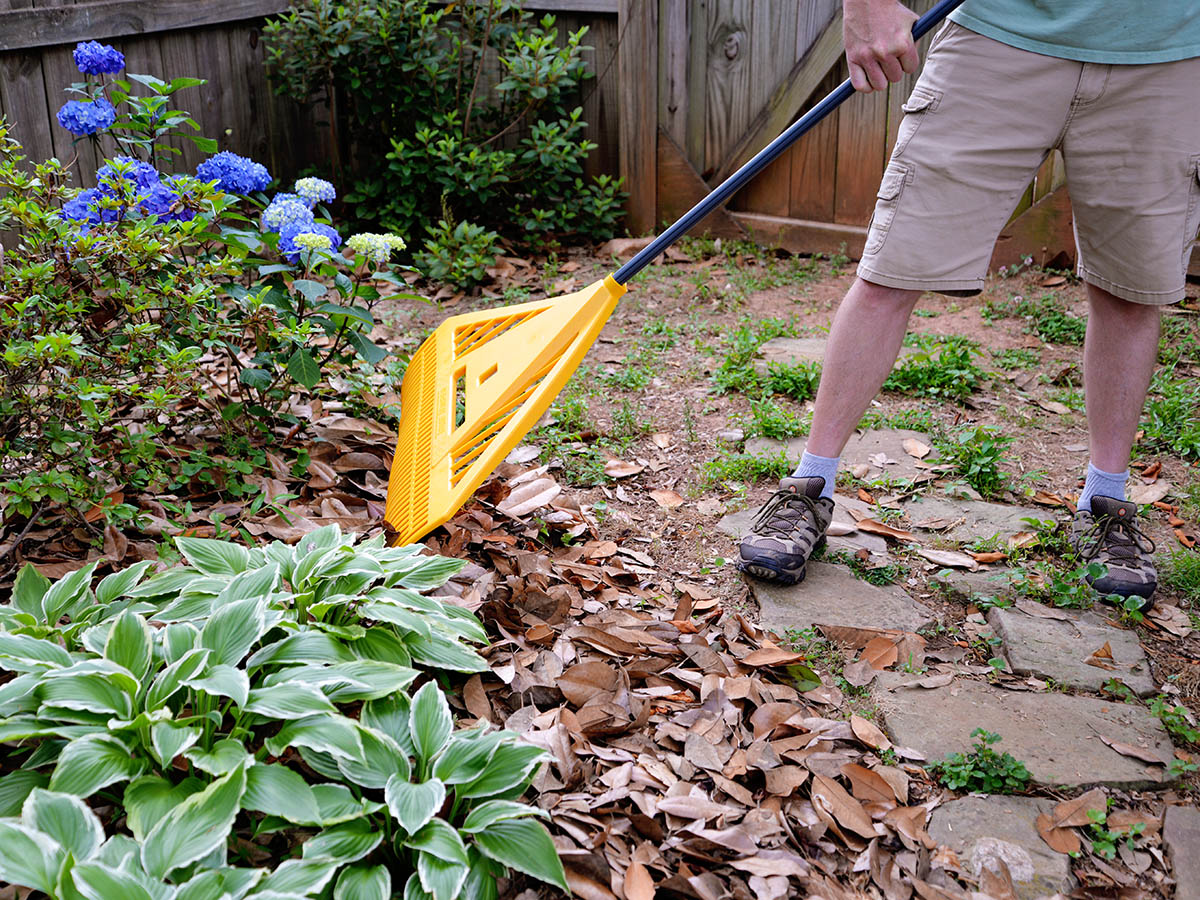
What to Consider When Choosing a Leaf Rake
While leaf rakes all serve a similar purpose, they vary widely in weight, length, materials, and quality. The best leaf rakes allow you to comfortably yet firmly grip the handle while performing the repetitive raking motions necessary to gather dry leaves and other yard debris. To find the best option, you’ll also want to consider the strength and flexibility of the tines, whether the length of the handle is adjustable, and whether you’d prefer a heavier or lighter rake.
Type
Leaf rakes are not the same as garden rakes, which have a stiff, broad head with short steel tines at a right angle to the handle. Garden rakes can break up dirt clods and dethatch a lawn, but leaf rakes are not suitable for that type of work.
- Standard leaf rakes feature a wide fan-style head with long, slightly flexible tines. Since a wider fan head covers a larger area, it usually can rake up leaves more quickly. The head attaches to a long handle to allow you to rake without bending over.
- Scoop leaf rakes come in two styles: single headed and double headed. A single-headed scoop rake resembles a standard leaf rake, but the fan-shaped head folds inward via a twist or pull-type mechanism on the handle. This allows the user to rake the leaves and then grab and lift them to a bag or compost pile. The double-headed style is not designed for raking but for lifting the leaves. It features two opposing scoop heads that open and close to grab and lift the leaves.
- Mini/hand scoop leaf rakes typically feature two separate curved rake plates—one for each hand. The user grabs the dry leaves and lifts them to a bag or bin.
Tines
Most rakes have tines made of metal, plastic, resin, or bamboo. Not only are the tines splayed, but each bends sharply downward at its outer end. These curved tines help grab the fallen leaves. Depending on the rake, the tines usually feature one or more cross braces near where they’re attached to the handle for stability.
The more cross braces a leaf rake has, the sturdier the tines and the less they will flex when raking. For raking heavy leaf falls, a sturdier rake head with at least two cross braces is desirable. Each tine material has its own benefits and drawbacks:
- Metal tines are the most durable and suitable option for medium- to heavy-duty yard work. Metal rakes with steel tines typically are heavier and more expensive compared to those made of plastic, bamboo, and resin.
- Plastic tines have the least amount of strength. They’re more appropriate for light-duty tasks since they break more easily. Plastic rakesare lightweight and inexpensive, but they don’t last as long as rakes made from other materials.
- Polyresin tines are a compromise between metal and plastic. This strong polymer combines the durability of metal with the flexibility of plastic to handle heavy-duty jobs.
- Bamboo is sturdy, though less durable than metal and resin. It’s a sustainable material and usually more eco-friendly than other materials (unless the metal, plastic, or resin comes from recycled products). Rakes with bamboo tines are suitable for light- to medium-duty work.
Ferrule
A leaf rake’s ferrule—the part of the rake head that attaches to the handle—is usually made from the same material as the tines and has similar qualities. Examine the ferrule to ensure that the rake head is securely attached.
A rake head may have a female screw-type ferrule that can connect to a standard male screw-type handle. Depending on the model, the ferrule also can have a bolt or two that secures it to the rake’s handle. In many cases, a broken handle doesn’t mean the entire rake must be replaced; instead, just the handle can often be replaced.
Handle
Rake handles are commonly made of wood, steel, aluminum, or fiberglass. When selecting an appropriate handle, keep the following characteristics in mind.
- Wood is the heaviest option, and while strong, it’s still susceptible to damage. Wood has the least amount of weather resistance and is subject to rot if left outdoors. Additionally, a wooden handle may eventually break if the rake is used for more challenging yard work.
- Steel and aluminum are more durable. Steel is the stronger metal and less likely to bend or dent. On the other hand, stainless steel, carbon steel, and aluminum handles resist corrosion and rust. Aluminum also is lighter than steel and often costs less.
- Fiberglass is tougher and lighter than steel, though it weighs more than aluminum. Rakes with a fiberglass handle are more expensive.
A leaf rake’s length determines its reach and how comfortable it is to use, and rake handles vary from 36 to 67 inches long or more. When choosing a rake, factor in the user’s height; longer handles are usually better for taller users.
Weight
Weight can be a critical factor when shopping for a leaf rake. Heavier rakes can become cumbersome and difficult to use over a long day of raking, while a lightweight rake makes it easier. However, lighter rakes may not be as durable or as able to complete heavy-duty tasks.
A rake can range in weight from less than a pound up to 5 pounds or more. A heavier rake comes in handy for tasks such as spreading mulch. If yard work involves both light-duty and heavy-duty tasks, you can compromise by opting for a medium-weight multipurpose rake of 2 to 3 pounds.
Additional Features
Rakes have various extra features that influence convenience and usability. If the tool will be used frequently, one or more of these features may be worth considering.
- Telescoping handles allow you to adjust the handle length to suit your preference or to accommodate multiple users of varying heights.
- Adjustable rake heads allow users to adjust the spread of the tines for different tasks.
- Grabber toolsbuilt into the head eliminate the need for bending down to retrieve swept leaves.
- Padded grips, usually made of rubber or foam, provide additional comfort and reduce hand fatigue.
- Collapsible handles save space and make it easier to store the rake in a garage or shed.
FAQs
An annual pastime in many communities after trees lose their leaves, raking can be a more enjoyable task. The right leaf rake speeds up the chore and simplifies the work. Those new to choosing a leaf rake are likely to have some questions. Answers to some common questions about these tools appear next.
While a few leaves here or there might not harm anything, a thick layer of autumn leaves can become damp and soggy, blocking sun and air circulation from the lawn and increasing the risk of fungal diseases. Raking the leaves helps remove excess coverage that could damage the grass.
Handheld leaf rakes (for raised beds) can be as short as 15 inches, while full-size leaf rakes may be 72 inches long or longer.
Both metal and plastic rakes expedite leaf raking, but metal usually lasts longer. However, the new polyresin in many of today’s plastic-type rakes is more durable than the plastic of yesteryear.
Add raked leaves to a compost pile or layer them around the base of trees and other plants for a bit of thermal protection during winter. Alternatively, bag them and contact the local waste authority for curbside pickup.
One method is not “better” than the other; it just depends on your needs. Maintaining your yard with a leaf blower certainly takes less time than raking leaves. However, raking is quieter (some areas have ordinances about using leaf blowers) and more environmentally friendly.
It’s actually better to rake leaves when they’re dry—they’re lighter and easier to lift, won’t stick together, and won’t breed mold while sitting in piles.
Wearing a mask while raking leaves will protect you from dust and mold spores. If you suffer from seasonal allergies, a mask can help decrease the chances of your symptoms being triggered.
To keep your rake in good condition, store it in a cool, dry place. It’s best if you can stow it indoors, hanging it above the ground.
Meet the Tester
With more than 20 years of experience in the nursery and landscaping industries, Mark Wolfe is a writer and product tester who reviews all the latest outdoor power equipment, hand tools, lawn-care products, and other outdoor-living goods.
Additional research provided by Andreana Lefton and Glenda Taylor.


